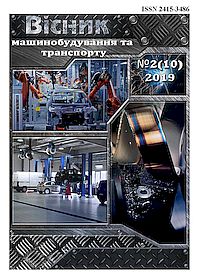Research agency approach to vehicle technical control
DOI:
https://doi.org/10.31649/2413-4503-2019-10-2-16-23Keywords:
car, agent, system, approach, element, service, multiagent systemAbstract
The analytical study of the agent approach, as a component of a multiagent system, which distinguishes it from other systems, is performed by the artificial intelligence of agents in order to increase the control of the technical condition of vehicles.
Purpose: to investigate the issue of the agent approach that is to use it as an additional or primary control in the maintenance of cars.
Today, with the already existing advances in the fields of IT technologies, mathematics, cybernetics, artificial intelligence and their interaction, there is little time to create a system that will change the concept of the car service system of the future, which will take the automotive industry to a new level. In such technologies, the principle of autonomy of individual parts, co-operating in a distributed system, where many processes take place simultaneously, is laid down.
Ultimately, it is concluded that the diversity of agent components and methods of creating multi-agent systems based on them and their application in the field of vehicle maintenance is a relevant topic. As a result of the performed analysis, it was found that for vehicles and structural components of their maintenance system, the reduction in the MAC will be the most favorable step in the modernization and improvement of the existing car maintenance system.
Agent control of the technical condition of vehicles will allow to optimize the technical maintenance of vehicles, reduce the waiting time for the maintenance of the vehicle, prevent the occurrence of new faults that may occur on the road and ensure compliance with environmental standards. The agent has the ability to fully function without interfering with anyone from the outside and to control the internal state and their actions. Unlike some adaptive systems, the agent has the ability to learn and reason. Therefore, during changes in the environment, it will be able to supplement its basic knowledge, which will help in the future to better find solutions to problems and will have more alternatives if one of them does not work.
References
[2] Е. А. Ощепкова, Информационные технологии на автомобильном транспорте. Кемерово, Россия: КузГТУ, 2012.
[3] Л. Н. Ясницкий, Интеллектуальные системы. Москва: Лаборатория знаний, 2016.
[4] Тарасов В.Б. От многоагентных систем к интеллектуальным организациям: философия, психология информатика. Москва, Россия: Эдиториал УРСС, 2002.
[5] М. И. Дли и Т. В. Какатунова, Нечеткие когнитивные модели региональных иннова-ционных систем Москва, Россия: Интеграл, 2011.
[6] В. М. Павленко і Ю. Ю. Свіріна, «Мультиагентний підхід при побудові системи технічного обслуговування і ремонту автомобіля,» Новітні технології розвитку автомобільного транспорту, 2018, с. 187.
[7] В. Лихтенштейн, В. Конявский, Г. Росс и В. Лось, Мультиагентные системы: самоорганизация и развитие. Москва, Россия: Высшая школа, 2008.
[8] J.-P. Briot, C. Felicíssimo and C. J. de Lucena, «A Norm-Based Approach for the Modeling of Open Multiagent Systems,» in Int. Conf. on Agents and Artificial Intelligence ICAART, Porto, 2009, pp. 540-546.
Downloads
-
PDF (Українська)
Downloads: 378


